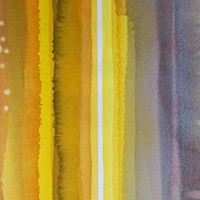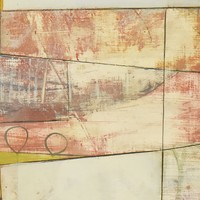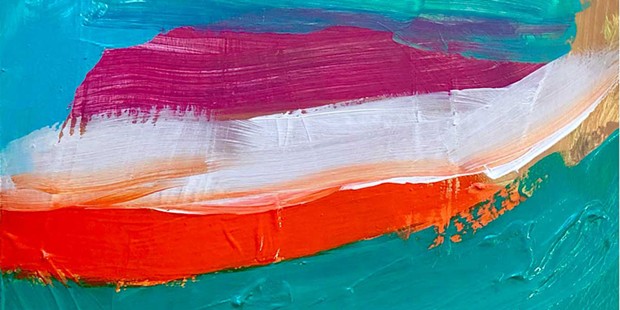Authentic Threads
Rachael Leal, Christine Bietz and Teresa Stanley at Canvas + Clay Gallery
By Gabrielle Gopinath[
{
"name": "Top Stories Video Pair",
"insertPoint": "7",
"component": "17087298",
"parentWrapperClass": "fdn-ads-inline-content-block",
"requiredCountToDisplay": "1"
}
]
Old Town Eureka's newest artspace Canvas + Clay opens this month in the handsomely renovated Buhne Building. The space boasts lofty ceilings, track lighting and pristine white walls, not to mention a logo that rejects the ampersand in favor of a fashion-forward plus. A tour of the sleekly remodeled exhibition space confirms the professional first impression.
The lively debut show assembles work by local painters Christine Bietz, Rachael Leal and Teresa Stanley. Bietz and Leal were selected for the show on the strength of work they produced in programs at Canvas + Clay's Eureka-based parent organization the Studio, a nonprofit fine arts center that offers art classes and workshops for people with disabilities. Stanley, a professor of painting at Humboldt State University, has had recent one- and two-person shows of her work in Kansas City, Missouri, Palo Alto and Eureka.
Intersecting lines and recessed spaces subdivide the picture plane in Stanley's paintings. The networks that result evoke blueprints, electrical circuit boards and draftsman's renderings. Bietz's work includes a series of vibrant portraits as well as "Schwestern Blumen," a large figure painting executed in free, elastic brushstrokes, with the smiling, brightly colored "flower sisters" referenced in the German title seeming to bounce across the queen-size canvas and its Delft blue sky. Leal is showing abstract paintings on panels and a selection of her hand-sewn dolls and stuffed animals, fashioned with button eyes, pointy ears, tails and wild patterns that make them look adorably off-kilter.
Program director Nicole Brown hopes to schedule future exhibitions that juxtapose works by artists who participate in Studio programs with ones made by artists drawn from the community at large. The focus, she says, will be "community, inclusivity and authentic art practices."
The Studio currently serves more than 60 artists ranging in age from their early 20s through their 70s, helping those who wish to pursue a vocation in the arts by offering pre-professional advice and making exhibition opportunities available. Staff work intensively with disabled people who make art "at every level of professional commitment," Brown says, from hobbyists to students with serious professional aspirations.
Stanley told me that as a longtime admirer of the Studio's programs, she had been honored to be asked to participate in the debut exhibition at Canvas + Clay. A trip with HSU painting students to the pioneering Oakland nonprofit for artists with disabilities called Creativity Explored made an impression on her when she visited several years ago. "I was blown away by the high quality of the work," she commented. There was this authenticity — this sense of a highly individual response to the world, where the creative impulse was not censored or altered by all this extra info."
When Kristi Patterson founded the Studio in 1997, along with her aunt Cheri Blackerby and her friend Lori Smith, she drew inspiration from the programming at Creativity Explored, which sought to integrate art by disabled artists into local communities. In our conversation about the Studio's origins, Brown also cited the importance of the example provided by an Oakland nonprofit called Creative Growth, which serves artists with disabilities by providing "a professional studio environment for artistic development, gallery exhibition and representation," according to its mission statement.
Brown's plans for Canvas + Clay include expanded program offerings. She envisions the gallery's large back room as a space where community members can attend lectures or make art in hands-on workshops, adding that she can also see the space functioning in the future as a semi-public studio where artists would be able to work adjacent to the exhibition space. "Showing the studio is such a part of being an artist now," Brown remarks. "It's all about authenticity. It's about getting a peek into the process of making the art work."
When I visit a workshop at the Studio the week before the exhibition opens, everyone I meet is excited about a field trip to the new gallery that afternoon. Some are shaping clay and drawing with pencils; some sleep peacefully through my visit, while others are eager to discuss the creation, marketing and pricing of their artworks. Holly Sepulveda shows me a lifelike ceramic octopus she has shaped in two pieces, now painted and ready for the kiln. Another artist, Gaylord Divine, gives me a hug and tells me about the decision to price his zebra sculpture at $100. Chris Johnson has a landscape painting currently on exhibition at the Morris Graves Museum of Art. He showed me a picture of the painting on his phone, then asked me to "like" it in an online contest. It shows a redwood grove with a vertical beacon of bright white light piercing the aperture between two giant trunks.
Paintings and sculpture made by people with disabilities tend to be presented and marketed as "outsider art." That term, coined in the 1970s, is used to designate works of art made by people whose creative development has been isolated from mass culture to varying degrees due to geographic, linguistic, cultural, physical, mental, and/or psychological constraints. It is often assumed that artists who fit this category stand outside history, and that the impulse behind their art is essentially visionary.
The mainstreaming approach to programming at Canvas + Clay suggests that the distinction between outsider and non-outsider art has lost much of its old relevance. Outsiders need mainstream currents to swim against but contemporary visual culture is radically eclectic. There are fewer shared reference points now that media consumption has become both politically divided and tailored to reflect the tastes of individual consumers. Plus, in magnifying the impact of every cultural niche, the internet has made outsiders of us all. The powerful impression of authenticity that artworks by disabled people can convey is bound to strike a chord with many viewers in this context.
Canvas + Clay Gallery is located at 233 F St., Old Town Eureka, (707) 443-1428. An opening party will be held July 7 during Arts Alive.
Speaking of...
-

Salt: Emily Silver and Holly Sepulveda
Jan 31, 2019 -

Water Seekers and Pretty Ones
Oct 5, 2017 - More »
more from the author
-
Nancy Tobin's CRy-Baby Installation at CR
- Feb 22, 2024
- More »

































